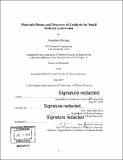| dc.contributor.advisor | Yang Shao-Horn. | en_US |
| dc.contributor.author | Hwang, Jonathan,Ph.D.Massachusetts Institute of Technology. | en_US |
| dc.contributor.other | Massachusetts Institute of Technology. Department of Materials Science and Engineering. | en_US |
| dc.date.accessioned | 2019-09-16T21:17:41Z | |
| dc.date.available | 2019-09-16T21:17:41Z | |
| dc.date.copyright | 2019 | en_US |
| dc.date.issued | 2019 | en_US |
| dc.identifier.uri | https://hdl.handle.net/1721.1/122157 | |
| dc.description | Thesis: Ph. D., Massachusetts Institute of Technology, Department of Materials Science and Engineering, 2019 | en_US |
| dc.description | Cataloged from PDF version of thesis. | en_US |
| dc.description | Includes bibliographical references. | en_US |
| dc.description.abstract | (Electro)catalysis is essential for addressing the most pressing societal and environmental challenges of this century, ranging from fossil fuel emission reduction to the production of sustainable fuels and chemicals. Among the technologies driven by (electro)catalysis are toxic gas abatement processes, greenhouse gas storage and utilization, and electrochemical energy storage and conversion devices like fuel cells, electrolyzers, and metal-air batteries. However, the field of (electro)catalysis has been historically hindered by a lack of guiding principles for materials selection and design, especially for increasingly complex materials systems such as oxides. This has stemmed from a lack of systematic studies of surface reactivity at thermodynamic conditions relevant to the reaction of interest and understanding of chemical origins of such reactivity trends. | en_US |
| dc.description.abstract | Thus, understanding the relationship between the bulk chemistry and surface reactivity can be a powerful tool to guide materials design for a wide range of (electro)catalytic processes. To drive forward the deployment of (electro)catalytic technologies, this work will first describe the need for mechanistically-driven and intuitive materials design principles. In order to develop this understanding, we then describe investigations on perovskite oxide model systems centered on oxygen-based, nitrogen-based, and carbon-based surface reactions relating to the oxygen evolution reaction (OER) structural stability for electrolysis, NOx reaction network for toxic gas abatement, and CO₂ gas reactivity for gas storage and conversion applications, respectively. | en_US |
| dc.description.abstract | Next, we translate insights regarding bulk-surface relationships to the complex electrochemical CO₂ reduction reaction, a reaction with a high degree of complexity for kinetics and selectivity, using the perovskite oxide materials family as a model system. We demonstrate that the bulk metal-oxygen covalency, quantified by parameters such as the O 2p-band center distance from the Fermi level, can rationalize activity trends for the production of CH₄ and H₂, where an intermediate covalency maximizes the former and high covalency maximizes the latter. Lastly, we investigate the role of surface coordination of Cu-based catalysts on the CO₂ reduction selectivity to high energy density chemicals and fuels, highlighting the role of careful understanding of surface reactivity. | en_US |
| dc.description.statementofresponsibility | by Jonathan Hwang. | en_US |
| dc.format.extent | 189 pages | en_US |
| dc.language.iso | eng | en_US |
| dc.publisher | Massachusetts Institute of Technology | en_US |
| dc.rights | MIT theses are protected by copyright. They may be viewed, downloaded, or printed from this source but further reproduction or distribution in any format is prohibited without written permission. | en_US |
| dc.rights.uri | http://dspace.mit.edu/handle/1721.1/7582 | en_US |
| dc.subject | Materials Science and Engineering. | en_US |
| dc.title | Materials design and discovery of catalysts for small molecule conversion | en_US |
| dc.type | Thesis | en_US |
| dc.description.degree | Ph. D. | en_US |
| dc.contributor.department | Massachusetts Institute of Technology. Department of Materials Science and Engineering | en_US |
| dc.identifier.oclc | 1117771354 | en_US |
| dc.description.collection | Ph.D. Massachusetts Institute of Technology, Department of Materials Science and Engineering | en_US |
| dspace.imported | 2019-09-16T21:17:38Z | en_US |
| mit.thesis.degree | Doctoral | en_US |
| mit.thesis.department | MatSci | en_US |
